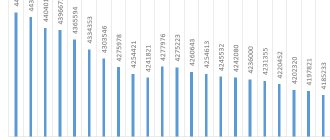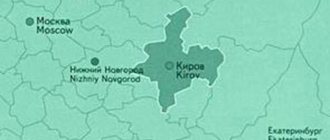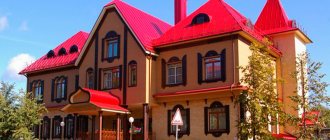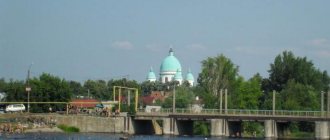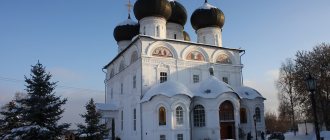In the Volgo-Vyatsky region in the Volga district is the Kirov region, whose population is 1,200 thousand people, of which 76% is urban. The list of cities in the Kirov region includes 18 settlements, the largest being the administrative center - Kirov. Founded in 1174 as the city of Vyatka, then it was renamed in 1457 to Khlynov, and in 1780 the previous name was returned. Only in 1934 did it begin to bear the name Kirov, where 500 thousand people currently live.
Geographical features
This region is located in the northeast of the Russian Plain. The size of the region along the meridian is 570 km, and in the latitudinal direction – 440 km. The distance from Kirov to Moscow is 896 km. The region is located within the Moscow time zone.
The Kirov region is characterized by hilly terrain. The northern part is significantly swampy. The climate is temperate, closer to cold. Severe frosts often occur in winter, and sudden cold snaps in summer. Precipitation amount is 500–700 mm per year. The region is characterized by a high level of forest cover.
Population of the Kirov region
The Kirov region is one of the largest in the European part of Russia. The total population of the Kirov region, according to 2018 data, is 1,283,400 people. At the same time, the average population density is 10.66 people. per km2. The share of city residents is 76.82%.
The region is characterized by an outflow of residents to other regions of the country: mainly to those located to the south and west of the Kirov region. Many moved to Yaroslavl and Moscow.
The population has been declining since at least 1900. During this time, it fell more than 2 times. Back in 2009, the population density was significantly higher – 11.3 people/km2. The share of urban residents, on the contrary, is lower – 72.1%. The working population was 911 thousand people.
The average life expectancy is very low and ranges from 60 to 70 years, depending on the year of birth.
Small towns up to 20 thousand people
Yaransk
Population 16,283 people (2016).
Sovetsk (Kirov region)
There are other meanings of this name, see Sovetsk
Population 15,719 people (2016).
Sosnovka
Population 11,420 people (2016).
The city, among other things, is home to the Sosnovsky Shipyard.
Zuevka
Population 10,697 people (2016).
White Kholunitsa
Population 10,597 people (2016).
Population 10,461 people (2016).
Urzhum
Population 9,975 people (2016).
Nolinsk
Population 9,703 people (2016).
Kearse
Population 9,639 people (2016).
Malmyzh
Population 7,591 people (2016).
Orlov
Population 6,834 people (2016).
Murashi
Population 6,384 people (2016).
National population structure
In 2010, representatives of more than 100 different nationalities lived in the Kirov region. Russians make up over 90% of the residents of the Kirov region. In second place are the Tatars - up to 3%. The share of Ukrainians is 0.76%. It is somewhat higher among local national communities - Mari and Udmurts (2.6 and 1.2%, respectively). There are small numbers of Azerbaijanis, Armenians, Gypsies, Belarusians, Germans, Chuvashs and Moldovans. The presence of other nationalities is insignificant. For example, there are only 0.03% of Jews.
In many areas of the region, the share of Russians is more than 95%. For example, in Kirov there are from 96 to 97% of them. The fewest Russian residents are in the Mamlyzhsky district - 45.4%, which is largely due to the high number of Tatars.
The most rural nationality is the Mari. More than 70% of them live in rural areas.
Number of people living in the capital and regional cities
Kirov is the regional capital. Therefore, residents of villages and villages flock there. According to statistics from 2022, a population of 500,836 people lives in the heart of the Kirov region. But in 2016 the figures were slightly lower – 495,998 people.
The population growth in Kirov is made up of applicants who come from villages, villages or nearby regions during the period of admission to universities. In addition, the number of residents is replenished by the working population who moved to the regional capital.
In 2015, Kirov took 37th place in the ranking of cities by the number of residents (then the indicators were recorded at 493,336 people).
By gender composition: there are more women than men. The percentage is 56%.
In terms of ethnic composition, Russians predominate. They make up 96% of the total number of residents.
In second place in terms of territorial and economic growth is the city of Kirovo-Chepetsk. In terms of population, it also ranks 2nd - 73,279 citizens. However, this figure is slightly lower compared to other years.
Kirovo-Chepetsk is located in 221st place out of 1112 possible in the list of Russian cities by number of residents.
According to its national composition, the city united the following peoples on its territory:
- Russians (95%);
- Tatars (1.5%);
- Udmurts (1.04%);
- Mari (0.23%).
The third largest city in the Kirov region is Slobodskaya. It has a population of 33,115.
And in 4th place is Vyatskie Polyany with a population of 32,817 inhabitants.
Every year, even in large cities of the Kirov region, there is a tendency for the urban population to decrease. And there are two reasons for this: low birth rate and high death rate. As well as the emigration of the indigenous population to more promising cities. This becomes evidence that these localities have weak economic indicators that affect the standard of living of its residents.
Population by city
The population of the cities of the Kirov region is uneven. The most populated city is Kirov. Over 500 thousand people live here. Kirovo-Chepetsk is in second place. About 73 thousand people live here. In other cities, the population is much lower. Almost everywhere there is a decrease in population. The only exception is the city of Kirov, where it grows. The largest cities are concentrated in the center of the region.
Population of the Kirov region by district
The region is divided into a large number of districts. However, the population of the districts of the Kirov region varies quite a lot. The most populated area in the Kirov region is the urban district of Kirov. Over 475 thousand people live here. In other regions the population is many times lower.
The most sparsely populated area is Bogorodsky district. Only 4,955 people live there. Almost the entire population there is Russian.
Regional districts
The administrative territorial division of the region includes 39 municipal districts. Let's consider some of them by the number of people living in their territories:
- Arbazhsky district is located in the southwest of the Kirov region. The urban-type settlement of Arbazh is its administrative center. The district is home to 6,056 residents.
- Bogorodsky district with a population of 4172 people is modestly located in the eastern part of the central part of the region. The administratively significant place is the urban-type settlement (hereinafter referred to as the urban-type settlement) Bogorodskoye.
- In the southeast of the region, the Malmyzh district has existed since 1929, in which the city of Malmyzh is the main regional entity. The population is 23,533 people.
- Nemsky district, with the administrative center - the town of Nema. Numbers 6928 villagers.
- 29,680 people live in the Orichevsky district. The village of Orichi is the administrative center.
- The Sovetsky district united 25,146 residents on its territory. The main regional subject is the city of Sovetsk.
- Lebyazhsky district has a population of 7,371 people. The administrative center is the urban-type settlement Lebyazhye.
- There are 9,773 inhabitants in the Pizhansky district.
- Falensky has a population of 9,247 people.
- Yaransky district united 23,753 residents.
Region population forecasts
Forecasts for the population dynamics of the Kirov region are rather discouraging. According to Kirovstat, every year the number of residents will decrease by approximately 5-7 thousand people. By 2031, the population of this region will be approximately 1,177,000 people.
The most rapid decline is expected in the rural population, partly due to migration to cities. However, according to forecasts, the number of urban residents will also decrease.
The ratio of men to women will remain approximately the same as now. There will still be more men than women.
The population of older age groups will grow by 5–8 thousand people until 2022, after which it will begin to decrease. In 2022 there will be approximately 393 thousand pensioners, and in 2031 – 379 thousand. Now there are about 367 thousand of them.
Natural population decline will increase. If now it is about 2,000 people per year, then in 2030 it will be about 5,400 people per year. A decrease in the birth rate is expected from 2022. At this time, a peak in migration outflow is expected, which will then gradually decrease.
However, there will also be positive trends. Thus, by the 2030s, average life expectancy in the region is expected to increase. For women it will approach 80 years, and for men – 71.
see also
- Kirov region
- Cities of Russia
| [ + ] Cities by regions of Russia | |
| Cities of the North-West (NWFD) | St. Petersburg (and its cities) • Leningrad region (historical Staraya Ladoga) • Arkhangelsk region • Vologda region • Kaliningrad region • Karelia • Komi • Murmansk region • Nenets Autonomous Okrug • Pskov region |
| Cities of the Volga region (Volga Federal District) | Bashkortostan • Volgograd region • Kalmykia • Kirov region • Mari El • Mordovia • Nizhny Novgorod region • Orenburg region • Penza region • Perm region • Samara region • Saratov region • Tatarstan • Udmurtia • Ulyanovsk region • Chuvashia |
| Cities of Southern Russia (SFD) | Sevastopol (including Inkerman) • Republic of Crimea • Adygea • Astrakhan region • Krasnodar region • Rostov region |
| Cities of the North Caucasus (NCFD) | Dagestan • Ingushetia • Kabardino-Balkaria • Karachay-Cherkessia • North Ossetia - Alania • Stavropol Territory • Chechen Republic |
| Cities of the Urals (Ural Federal District) | Kurgan region • Sverdlovsk region • Tyumen region • Khanty-Mansi Autonomous Okrug - Yugra • Chelyabinsk region • Yamalo-Nenets Autonomous Okrug |
| Cities of Siberia (Siberian Federal District) | Altai Republic • Altai Territory • Irkutsk Region • Kemerovo Region • Krasnoyarsk Region • Novgorod Region • Novosibirsk Region • Omsk Region • Tomsk Region • Tyva • Khakassia |
| Cities of the Far East (FEFD) | Amur Region • Buryatia • Jewish Autonomous Region • Trans-Baikal Territory • Kamchatka Territory • Magadan Region • Primorsky Territory • Sakha (Yakutia) • Sakhalin Region • Khabarovsk Territory • Chukotka Autonomous Region |
| see also | Cities of the DPR, LPR, Transnistria, South Ossetia • Regions of Russia • Cities of Russia |
Employment
According to official reports from the regional employment center, the employment situation in the region is stable. The unemployment rate is very low at only 1.1%. The total number of unemployed is 7,700 people. It is also noted that this figure is the lowest in the entire history of the center.
Employment levels vary greatly across areas. In 19 districts of the region, official unemployment exceeds the average by 2 times, and in five districts - by 3 times. The lowest unemployment rate is in Kirov, as well as in the Sovetsky, Urzhumsky, and Slobodsky districts.
In 2016, the number of vacancies provided by Kirov employers was 20 percent more than in the same period last year. The largest number of available vacancies (i.e., shortage of personnel) is observed in such areas as construction, mechanical engineering, information technology and agriculture.
There are also plenty of vacancies for doctors and engineers.
It is difficult to get a job in the Kirov region in such professions as lawyer, economist, accountant. Competition for 1 workplace in the listed specializations ranges from 5 to 18 people registered with the center.


